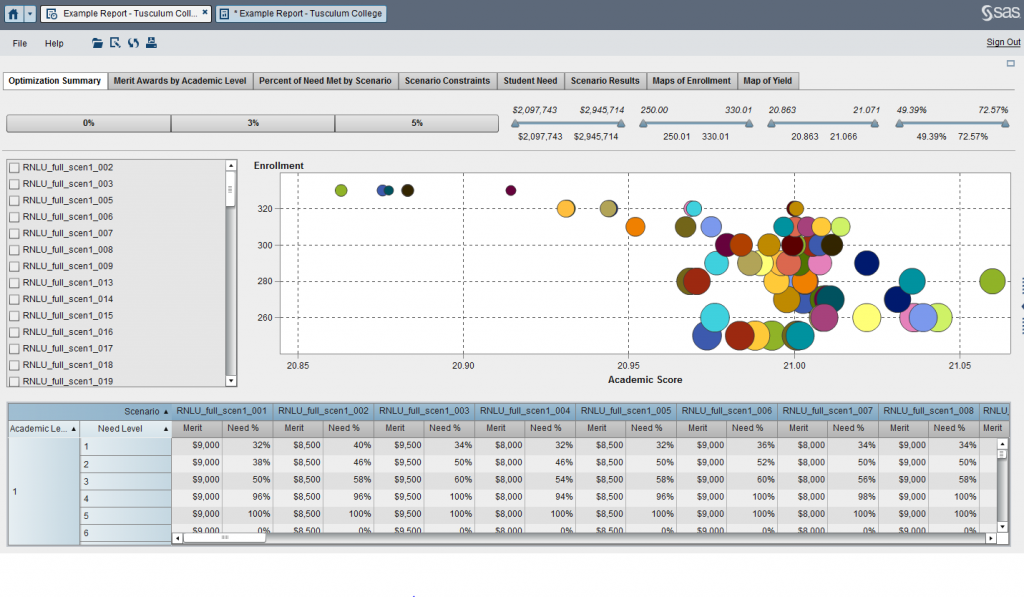For colleges and universities, awarding financial aid today requires sophisticated analysis. When higher education leaders ask, “How can we use financial aid to help meet our institutional goals?” they need to consider many scenarios to balance strategic enrollment goals, student need, and institutional finances in order to optimize yield and net revenue.
 Consider this example: a university can’t go above a 70 percent discount rate, requires a minimum class size of 300, and needs to have a quality profile of at least a 1200 SAT.
Consider this example: a university can’t go above a 70 percent discount rate, requires a minimum class size of 300, and needs to have a quality profile of at least a 1200 SAT.
The number of scenarios to consider is vast – which is why universities use advanced analytics like optimization to help make their financial aid decisions. Being able to narrow the focus and dynamically adjust analyses with what-if scenarios is key. Testing and optimizing for various scenarios gives the institution confidence in knowing what is possible and what they can accomplish. With that analysis, they can also set realistic boundaries and expectations for the goals of their institution.
Ultimately, Institutions need to identify students who will and will not respond to changes in financial aid, so they can be more strategic with their financial aid awarding process. Indeed, financial aid is a main reason clients’ partner with Ruffalo Noel Levitz, a provider of consulting and analytics services for the higher education market.
Ruffalo Noel Levitz uses advanced modeling to help clients achieve three key objectives for enrollment and financial aid management:
- Balance affordability and resources by calculating the aid packages needed to enroll specific populations of students.
- Develop a strategic financial aid plan that addresses enrollment goals and optimizes financial aid awards.
- Maximize net tuition revenue to maintain and improve the quality of academic programs and campus services.
According to Tim Schuldt, Director of Statistical Delivery at Ruffalo Noel Levitz, “We’ve used several SAS products over the years and found that they served us the best in financial aid delivery. Partnering with SAS on the next step of broadening and developing our work was a logical step.”
First, using SAS Enterprise Miner, they build econometric models to estimate each student’s probability of enrollment based on a number of data points. Once that is completed, they use SAS/OR software to create several different financial aid “scenarios” based on the client’s overall objectives and goals for their institution.
Schuldt explains, “Adding SAS/OR to our product suite has opened the door for a brand new level of optimization analytics within our Financial Aid Services division. Complementing this service with SAS Visual Analytics, and being able to deliver recommendations visually, has been instrumental in allowing us to deliver this new product to market. In fact, our clients have shown a lot of excitement in the easy-to-digest output, and our consultants have told us that this output has opened the door for new and more engaging conversations on campus.”
In a recent demo, Schuldt shows how scenario selection works. He changes one decision (say, understanding the impact of lowering the desired discount rate from 70% to 65%) and the visualization dynamically reveals only those possible scenarios that are relevant to the requested change. This allows for campus leadership to discuss next steps proactively rather than reactively.

Using advanced analytics, Ruffalo Noel Levitz can develop unique awarding parameters for each campus. Institutions can use the results to:
- Determine how much aid is needed to execute their strategic plan.
- Estimate the impending impact that different scenarios have on enrollment.
- Test awarding scenarios to meet the internal goals of the institution.
With this information, institutions can create more effective financial aid policies and standards that aim to meet the internal goals of their institution while also aligning themselves more strategically in the marketplace.
For more information read a whitepaper on how SAS can helps institutions with analytics across the student lifecycle.
